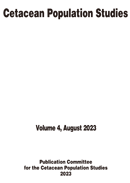Current issue
Displaying 1-12 of 12 articles from this issue
- |<
- <
- 1
- >
- >|
-
2023 Volume 4 Pages 1
Published: October 11, 2023
Released on J-STAGE: October 11, 2023
Download PDF (166K) -
2023 Volume 4 Pages 3
Published: October 11, 2023
Released on J-STAGE: October 11, 2023
Download PDF (195K)
Full paper
-
2023 Volume 4 Pages 7-18
Published: October 11, 2023
Released on J-STAGE: October 11, 2023
Advance online publication: October 25, 2022Download PDF (965K)
Short note
-
2023 Volume 4 Pages 21-26
Published: October 11, 2023
Released on J-STAGE: October 11, 2023
Advance online publication: June 06, 2023Download PDF (1384K) -
2023 Volume 4 Pages 27-33
Published: October 11, 2023
Released on J-STAGE: October 11, 2023
Advance online publication: June 09, 2023Download PDF (737K) -
2023 Volume 4 Pages 34-39
Published: October 11, 2023
Released on J-STAGE: October 11, 2023
Advance online publication: June 13, 2023Download PDF (683K)
Others
-
2023 Volume 4 Pages 43-44
Published: October 11, 2023
Released on J-STAGE: October 11, 2023
Advance online publication: March 29, 2023Download PDF (355K) -
2023 Volume 4 Pages 45-47
Published: October 11, 2023
Released on J-STAGE: October 11, 2023
Advance online publication: June 09, 2023Download PDF (532K)
-
2023 Volume 4 Pages 49-50
Published: October 11, 2023
Released on J-STAGE: October 11, 2023
Download PDF (197K) -
2023 Volume 4 Pages 51-53
Published: October 11, 2023
Released on J-STAGE: October 11, 2023
Download PDF (190K) -
2023 Volume 4 Pages 54-56
Published: October 11, 2023
Released on J-STAGE: October 11, 2023
Download PDF (141K) -
2023 Volume 4 Pages 57
Published: October 11, 2023
Released on J-STAGE: October 11, 2023
Download PDF (173K)
- |<
- <
- 1
- >
- >|
